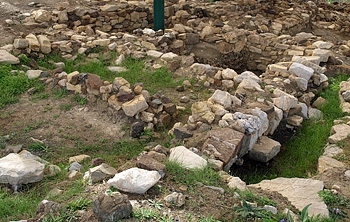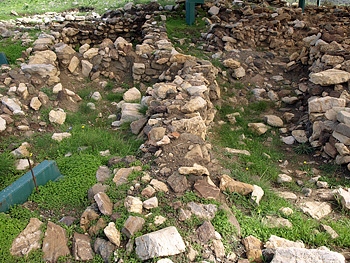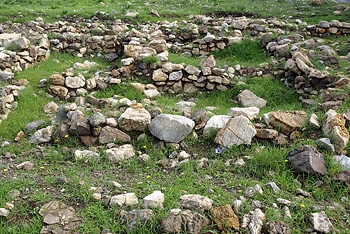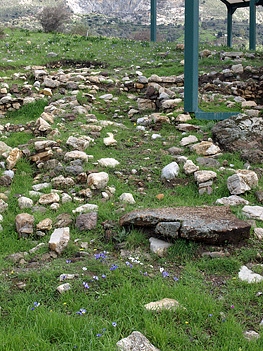Building B
Building B is located north-east of building A and divided from it by a path (13). It has only been partly excavated but in the opinion of the excavators in the first period of use it would have formed one complex with Building A, only being separated at a later date.
Four rooms have been uncovered in Building B (14, 15, 20 and 20b). It is not known how the rooms communicated with each other. It is thought that the building had an upper floor as fragments from large vessels were found in the upper part of the collapse layer.
Among the finds in Building B were conical cups, fragments of stone vessels, a grater made of bronze and a mold for making bronze swords. It is thought that room 15 may have been both a storage magazine and a workshop as a pithos and a small bronze tool were uncovered here.
Building G
Building G has only been very partially excavated. It lies to the east of Building A and south of Building B. Only one room has been excavated (22) and it seems to have been used as a kitchen. Finds here included a conical cup, a tripod pot, and a hearth filled with charcoal and bone on which two tripod pots were found in situ. When analysed, fragments of the tripod pots were shown to contain traces of various plants, fruits and leafy vegetables.
Building D

Building D forms a unified structure with the older, adjacent building A. The west facades of the two buildings have been regularised by the construction of the perimeter facade of the settlement and the excavators believe that Building D was constructed at the same time as the construction or the extension of this wall. Building D has not been completely excavated. In particular the central rooms on the east side of the building remain to be examined.
The building is approximately 120 square metres in area and there is no visible opening to the outside through any of the excavated walls. This leaves the possibility that the unexcavated section of the east wall, which opens onto the northwest-southeast pathway (13), may be the point at which the building was entered.
A number of the rooms (19, 27, 28, 34 and 40) seem to have no way of communicating with each other. Only room 51 has a way of communicating with room 41, and this was blocked up in a later period. So it is possible that in the original building these rooms were partly or completely underground and were accessed from an upper floor. This upper floor would have been entered from the pathway to the east of the building. Support is given to this theory by the discovery of what is thought may well be steps leading to an upper floor in room 51.
So anyone walking along pathway 13 in the direction of Building G and entering the buildings there would have gone into the ground floor rooms of possible two-storey buildings (i.e. Buildings C and B) to the east of the pathway which were further uphill, but into first floor rooms constructed above basements in the two-storey buildings (D and A) on the west side which were downhill from the pathway.
Room 51 had a platform built directly onto the ground rock, possibly because it proved too difficult to remove the ground rock in order to level the floor. The platform may have been used for storing vessels. A number of graters and polishers were found in room 51 leading the excavators to speculate that it may have been a workshop.
Room 28 contained a stone bench and a number of stone fragments, some of which had been worked on. Consequently the excavators believe that this room may have been a stoneworker's workshop.
Building F

Building F is surrounded on three sides by passageways. The east side faces pathway 39 which turns in a south-west direction at the south-east corner of the building. The south wall of Building F forms the north wall of the main entrance into the settlement while to the west there is the perimter wall and pathway that runs along the west facade of the building.
Building F has an internal area of about 62 square metres made up of 6 rooms (Nos. 36, 37, 38 a and b, 46, 47). It seems to have had at least two different stages of use, revealed by the placing of newer walls over older ones and the closing up of doorways.
Initially all the rooms on the east side of the building had doorways opening onto the pathway (39) but in a second period all these were blocked off apart from room 46, whose ground floor is lower than the pathway and is therefore accessed down three steps. So in the second period of the building's existence this was the only access from the east. Excavators believe but cannot yet establish that there may have been access from the west into room 38.
Room 37 was constructed on two slightly different levels connected by two steps. In the lower level a hearth was found. However the excavators do not feel able on the basis of current evidence to ascribe uses to the rooms in the building. Finds include the base of a small zoomorphic idol made of bone, a fragment of pithos and a seal mold with a geometric pattern which dates from the protopalatial period.
Unallocated rooms

The area east of Building F contains a number of rooms which have not been allocated by the Italians to a particular building or labelled in any way (although the Greek archaeologist has named this building Greek Eta (H) in her version of the site plan using solely Greek letters of the alphabet. She also does not recognise Building G as a distinct building on her plan).
The northwest to southeast pathway 39 runs along the west facade of the building and it is also thought that the long narrow area 48 may have been used to access the complex.
The northern part of the building seems to comprise a unit of four rooms (42, 43, 44, 45). The largest room (43) seems to have two entrances: it could be entered through a doorway in the western wall from pathway 39 while a second entrance was located leading off the long narrow space 48, mentioned above. This entrance is still marked by a threshold consisting of two stone slabs.
Only the upper part of room 43 has been fully excavated and it revealed a stone bench on which a clay libation vessel was found in situ. Room 43 communicated with room 42, but the other two rooms in this part of the building, 44 and 45, do not seem to have entrances and presumably would have been accessed from above.
The second group of rooms (49, 50 and 52) line up in a row southeast of space 48. The west wall of this part of the building is constructed in typical Minoan fashion with larger more regular stones on the outside and smaller, unworked stones held in place by mud mortar on the inside. Room 52, next to this wall, is the only room fully excavated in this group. The room was entered at its southwest corner where two threshold stones remain in situ. Based on finds from this room and room 50, they were both kitchens. Three large coarseware pots used in the preparation of food were found in situ against the north wall as well as fragments of tripod pots.
The pathways

Pathway 13/39
Pathway 13 starts at Building G and runs northwest with Building A on its left and building B on its right. Where the path would have passed between Buildings C and D it has not been excavated so its continuation to path 39 remains conjectural, though likely. Its presumed continuation between the unexcavated Building C and Building D would thus join with pathway 39 at the north end of Building D, where the main entrance to the settlement rises up to join the pathway.
It seems, therefore, that pathway 39 was a continuation, in the north sector, of pathway 13. At any rate, the pathway assumed the function of the main NW-SE communication axis between the buildings at the northwest end of the settlement.
Pathway 39 runs from the NW edge of the excavated area, for approximately 15 metres in total. For the first 9.5 metres, it separates building F, to the southwest from the northeastern complex of unallocated rooms constituted by rooms 42, 43, 44 and 45 and is about one metre wide. A few large stone slabs still in situ suggest that the path would originally have been paved.
Immediately south of the entrance to room 43 in the unallocated group of rooms, there are steps consisting of three stones where the pathway changes level. At the southeast corner of building F the path opens into a slightly broader area and continues along the northeast side of house D until it reaches the unexcavated area.
In a first period, the pathway northeast of building D was in direct communication with the first portion of pathway 39; for reasons not yet elucidated, in a second stage this area was blocked off, separating the first section of the corridor (that is, the entire portion to the northeast of unit F) from its continuation towards the southeast. So, what was at first a public space became the private space of one of the adjoining houses.
Area 48
Area 48 runs at right angles in a northeasterly direction for a few metres from pathway 39 just after the change in level of that pathway. Its elongated shape, its size and the floor, consisting of a number of large stone slabs, suggest that it could be a branch of Corridor 39 and may well have been paved originally. At a later stage it seems that the area was blocked off from pathway 39 by a wall. As already mentioned, room 43 of the unallocated rooms opens into Area 48.
The west entrance
Between Buildings F and D, there is a wide passageway, only partially revealed. It is divided into three areas separated by door jambs that indicate doorways. This passageway, following the natural slope of the hill in a northeast to southwest direction, leads to the western entrance of the settlement. Here a large rock with a very smooth surface seems to play the role of a threshold that interrupts the continuity of the perimiter wall.
NOTE: The Italians often describe the location of the buildings on the site as if north was facing to the top of the site plan when looked at in landscape view. However, the site is actually on a northwest-southeast axis so that north actually points more or less across the page from left to right making the left hand side of the site plan closer to north than to west and the right hand side closer to south than to east. In my coverage I have changed the references to position made by the excavators to reflect this.




